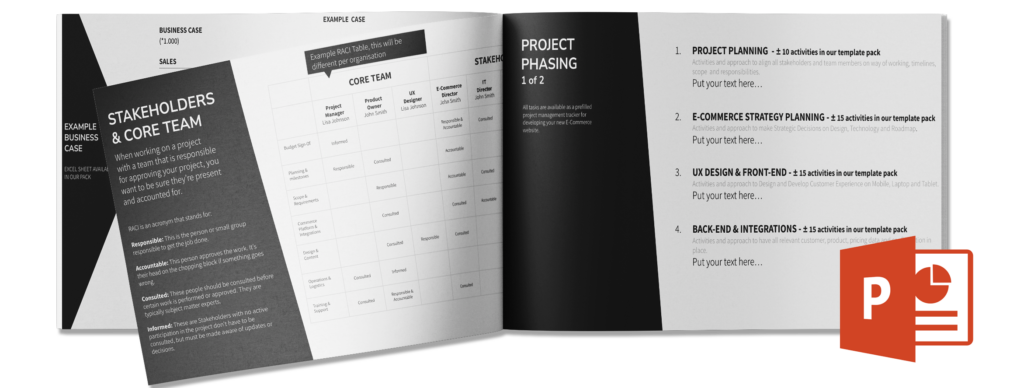Use my Free E-commerce Website Project plan Template to ensure you wil be successful in launching your new e-commerce website. Our free project plan template is specifically designed for e-commerce website projects and covers all the essential elements, including project scope, timeline, budget, resources, and deliverables.
All 7 phases in one Template: Free E-Commerce Website Projectplan
Now, what are those 7 Phases in my Free Sample Project plan Template that you need to plan in detail?
Phase 1. Projectplan Planning Phase
Effective stakeholder management is an important aspect of the project plan template . This involves identifying all the individuals and groups who have a stake in the success of the e-commerce project, and ensuring that their needs and concerns are considered throughout the planning and execution process. This can include customers, employees, shareholders, and other stakeholders who may be affected by the project. By engaging with stakeholders and keeping them informed about the progress of the project, you can build support for the project and reduce the likelihood of conflicts or delays.

Budget management is also an essential part of a the free e-commerce project plan template. Also check our E-Commerce Business Case Calculator in Excel. This involves identifying the costs associated with each task and resource, and allocating funds accordingly. A well-crafted budget can help to ensure that the project stays within its financial constraints, and can help to prevent overspending or underfunding. By regularly reviewing the budget and tracking expenses, you can stay on top of the financial health of the project and make any necessary adjustments to keep it on track.
Phase 2 – E-Commerce Planning
An e-commerce strategy is an important part of running a successful online business. It provides a roadmap for how the business will use e-commerce to achieve its goals and objectives. Some key elements of an e-commerce strategy may include:
- A clear definition of the target audience and market for the business, including an understanding of the customers’ needs, preferences, and buying habits.
- A detailed plan for how the business will use e-commerce to reach and engage its target audience, including the channels and platforms that will be used, the types of products and services that will be offered, and the pricing and promotions that will be used.
- A plan for how the business will use e-commerce to drive revenue and profit, including a detailed understanding of the costs and margins associated with the products and services being offered.
- A plan for how the business will use e-commerce to support its overall business strategy, including how it will integrate with the company’s other channels and systems.
- A plan for how the business will measure and evaluate the success of its e-commerce strategy, including the key performance indicators (KPIs) that will be used, and how the strategy will be adjusted over time in response to changing market conditions and customer needs.
Phase 3 – UX-Design & Front-End
UX design (user experience design) is the process of designing products, systems, or services with the user’s needs and preferences in mind. The goal of UX design is to create e-commerce websites that are easy, efficient, and enjoyable to use. UX designers use a variety of tools and techniques to research, prototype, and test the user experience of a product, and to iterate on the design based on user feedback. Our Free PowerPoint Projectplan Template ensures that all steps are taken to get a user centered e-commerce website.
Front-end development, on the other hand, is the process of implementing the user interface (UI) of a product, using a combination of HTML, CSS, and JavaScript. Front-end developers are responsible for implementing the visual design and functionalities of the user interface, as well as ensuring that the UI is responsive and accessible across different devices and browsers.

In teams, UX designers and front-end developers often work together to design and develop the user experience of a product. The UX designers may create wireframes, prototypes, and other design artifacts to communicate their ideas and gather feedback, while the front-end developers implement the user interface based on the UX designers’ specifications. Through collaboration and iteration, the UX designers and front-end developers can ensure that the product provides a seamless and enjoyable user experience.
Project plan Phase 4 – Back-End & Configurations
Back-end development is the process of building and maintaining the server-side of a web application or website. The back-end typically includes the database, server-side logic, and any other systems or components that are needed to support the functionality of the web application or website.
Back-end developers are responsible for implementing the server-side logic of a web application or website, including handling user requests, managing data storage and retrieval, and implementing security measures. They may also be responsible for integrating the web application or website with other external systems and services, such as payment processors, shipping carriers, and other third-party APIs.
To manage all of the integrations in a project, it is important to have a clear understanding of the different systems and services that are involved, and to plan out the integration process carefully. This may involve creating detailed integration specifications, defining the data flow and mapping between systems, and testing the integration to ensure that it is working correctly. It is also important to have a system in place for monitoring and managing the integrations over time, to ensure that they continue to function smoothly and provide the desired benefits.
Project plan Phase 5 – Marketing Readiness
Online marketing is the process of promoting and selling products or services using the internet. It includes a wide range of activities, such as search engine optimization (SEO), social media marketing, email marketing, content marketing, and online advertising.

To prepare for launching a new e-commerce website, it is important to create a detailed online marketing plan that outlines the specific strategies and tactics that will be used to promote and sell the website’s products and services. This may involve conducting market research to understand the target audience and their preferences, creating a content and social media plan to engage and attract potential customers, and setting up online advertising campaigns to drive traffic to the website. Check my Free Sample Project Plan Template to get all tasks in your Planning
It is also important to have a plan in place for tracking and measuring the success of the online marketing efforts, in order to continually improve and optimize the marketing strategy over time. This may involve using tools and technologies for tracking website traffic and customer behavior, as well as gathering customer feedback and conducting regular market research to understand the effectiveness of the marketing efforts. Overall, careful planning and execution of an online marketing plan is essential for the success of a new e-commerce website.
When migrating to a new website platform, there are several online marketing tips that can help to ensure a successful transition. Make sure the project plan includes:
- Communicate with customers: Let your customers know that you are migrating to a new website platform, and explain why this is happening and what benefits it will provide. This will help to ensure that customers are aware of the change and can prepare for it.
- Redirect old URLs: Make sure to redirect any old URLs to the corresponding new URLs on the new website platform. This will help to ensure that customers can still access the content on the old website, and will prevent any broken links or other issues.
- Update your marketing materials: Update any marketing materials, such as ads, social media posts, and email campaigns, to reflect the new website platform. This will help to ensure that customers are aware of the new website and can easily find it.
- Monitor and optimize: Monitor the performance of the new website platform, and use analytics and customer feedback to identify any areas for improvement. This will help to ensure that the new website is meeting the needs of customers and providing a positive user experience.
Overall, these online marketing tips can help to ensure a smooth and successful transition to a new website platform. By communicating with customers, redirecting old URLs, updating marketing materials, and monitoring and optimizing the performance of the new website, businesses can minimize disruption and ensure that the new platform is a success.
Project plan Phase 6 – Testing
When launching a new website, it is important to conduct proper testing to ensure that the website is functioning correctly and providing a good user experience. Some key steps in your Project Plan for conducting proper testing when launching a new website can include:
- Define the testing plan: Create a detailed testing plan that outlines the specific tests that will be conducted, the tools and technologies that will be used, and the criteria for success.
- Test the functionality: Test the functionality of the website to ensure that it is working correctly and providing the desired features and capabilities. This may involve testing the website’s user registration and login process, the checkout and payment process, and any other key functionalities.
- Test the user experience: Test the user experience of the website to ensure that it is intuitive, easy to use, and provides a good overall user experience. This may involve testing the website on different devices and browsers, and gathering user feedback to identify areas for improvement.
- Test the performance: Test the performance of the website to ensure that it can handle high levels of traffic and load without slowing down or crashing. This may involve using tools and technologies for simulating traffic and measuring the website’s response time and other performance metrics.
Project plan Phase 7 – Go Live
When launching a new e-commerce website, there are several key go-live activities that need to be completed in order to ensure that the website is ready for public use. Your Projectplan must include:
- Final testing: Before the website goes live, it is important to conduct a final round of testing to ensure that the website is functioning correctly and providing a good user experience. This may involve testing the website’s functionality, performance, user experience, and other key aspects.
- Content migration: If the website is replacing an existing website, it may be necessary to migrate the content from the old website to the new website. This may involve copying over text, images, videos, and other types of content, and ensuring that the content is properly formatted and organized on the new website.
- Domain and DNS configuration: The website’s domain name and DNS (Domain Name System) settings need to be properly configured to ensure that users can access the website using the correct domain name. This may involve updating the DNS records and other settings on the domain name registrar’s website.
- Integration with external systems: If the website needs to integrate with external systems, such as payment processors or shipping carriers, it is important to ensure that these integrations are properly set up and tested before the website goes live.
- Marketing and promotion: Before the website goes live, it is important to have a plan in place for marketing and promoting the website to potential customers. This may involve creating ads, social media posts, and other marketing materials, and launching online advertising campaigns


